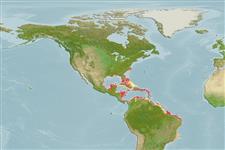>
Blenniiformes (Blennies) >
Blenniidae (Combtooth blennies) > Salariinae
Etymology: Parablennius: Greek, para = the side of + Greek, blennios = mucus (Ref. 45335).
More on author: Poey.
Environment: milieu / climate zone / distribuzione batimetrica / distribution range
Ecologia
marino associati a barriera corallina; distribuzione batimetrica 0 - 10 m (Ref. 9710). Subtropical; 36°N - 27°S, 98°W - 34°W
Western Atlantic: New York (USA), Bermuda, the Bahamas, Gulf of Mexico to southern Brazil.
Size / Peso / Age
Maturità: Lm ? range ? - ? cm
Max length : 8.5 cm TL maschio/sesso non determinato; (Ref. 7251)
Spine dorsali (totale) : 12; Raggi dorsali molli (totale) : 18; Spine anali: 2; Raggi anali molli: 19 - 20. No median row of cirri; supraorbital cirri branched (Ref. 26938). With numerous small brown spots; small black spot at front of dorsal fin; edge of anal fin pale (Ref. 13442).
Body shape (shape guide): fusiform / normal.
Facultative air-breathing in the genus (Ref. 126274); Adults inhabit eroded basins and limestone boulders covered by an algal mat, sea fans, etc. (Ref. 5521). Sometimes around mangrove roots, young are sometimes found in floating Sargassum (Ref. 26938). Omnivorous, but feed mostly on algae (Ref. 13442). Oviparous. Eggs are demersal and adhesive (Ref. 205), and are attached to the substrate via a filamentous, adhesive pad or pedestal (Ref. 94114). Larvae are planktonic, often found in shallow, coastal waters (Ref. 94114).
Life cycle and mating behavior
Maturità | Riproduzione | Deposizione | Uova | Fecundity | Larve
Oviparous, distinct pairing (Ref. 205).
Robins, C.R. and G.C. Ray, 1986. A field guide to Atlantic coast fishes of North America. Houghton Mifflin Company, Boston, U.S.A. 354 p. (Ref. 7251)
IUCN Red List Status (Ref. 130435: Version 2025-1)
Threat to humans
Harmless
Human uses
Pesca: di nessun interesse; Acquario: Commerciale
Strumenti
Special reports
Download XML
Fonti Internet
Estimates based on models
Preferred temperature (Fonte Biblio.
123201): 23.5 - 28.2, mean 27.2 °C (based on 572 cells).
Phylogenetic diversity index (Fonte Biblio.
82804): PD
50 = 0.5000 [Uniqueness, from 0.5 = low to 2.0 = high].
Bayesian length-weight: a=0.01096 (0.00465 - 0.02585), b=2.99 (2.81 - 3.17), in cm total length, based on LWR estimates for this Genus-body shape (Ref.
93245).
Trophic level (Fonte Biblio.
69278): 2.5 ±0.23 se; based on food items.
Resilienza (Fonte Biblio.
120179): Alto, tempo minimo di raddoppiamento della popolazione meno di 15 mesi (Preliminary K or Fecundity.).
Fishing Vulnerability (Ref.
59153): Low vulnerability (10 of 100).
🛈
Nutrients (Ref.
124155): Calcium = 97.8 [37.6, 198.2] mg/100g; Iron = 0.951 [0.516, 1.730] mg/100g; Protein = 19.3 [18.1, 20.4] %; Omega3 = 0.208 [0.110, 0.386] g/100g; Selenium = 8.81 [4.00, 19.36] μg/100g; VitaminA = 78.6 [21.8, 279.3] μg/100g; Zinc = 1.65 [1.02, 2.60] mg/100g (wet weight);
